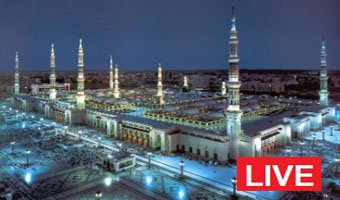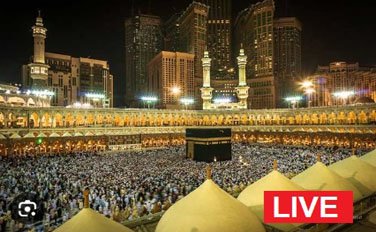Beautiful and Ancient Mosques in Syria

How Many Mosques Are There in Syria?
As of my last update in January 2022, there wasn’t a specific, up-to-date count of the number of mosques in Syria. The country has a rich Islamic heritage, and mosques are integral to its cultural and religious identity. However, due to the ongoing conflict and displacement in Syria, the situation may have changed.
Before the conflict, Syria was home to numerous mosques, ranging from small neighborhood mosques to historic landmarks like the Umayyad Mosque in Damascus. Additionally, many towns and cities across Syria have multiple mosques serving their communities.
It’s essential to note that the conflict has likely impacted the status of mosques in Syria, with some being damaged or destroyed, and others serving as shelters or makeshift facilities for displaced people.
For the most accurate and up-to-date information on the number of mosques in Syria, it would be best to consult recent reports from organizations involved in humanitarian efforts or cultural preservation in the region.
Umayyad Mosque: Resplendent Legacy of Aleppo
Embark on a journey through time and marvel at the architectural splendor of the Great Mosque of Aleppo (also known as the Umayyad Mosque of Aleppo). This historic mosque, Aleppo’s largest and one of its oldest, stands as a testament to the rich cultural heritage of Syria.

Originally built in the early 8th century CE on the site of a former Roman temple and Byzantine church, the mosque has undergone numerous transformations throughout the centuries. While the initial Umayyad-era structure is no longer present, the current building offers a captivating glimpse into Islamic art and architecture, particularly from the Seljuk and Ayyubid periods.
Key architectural elements to look out for include:
- The towering square-planned stone minaret dating back to 1090, adorned with intricate geometric patterns.
- The serene courtyard, renowned for its black and white stone pavement forming mesmerizing geometric designs.
- The elegant prayer hall, potentially incorporating remnants of the mosque’s earlier incarnations.
Beyond its architectural significance, the Great Mosque of Aleppo holds deep religious importance. According to tradition, it’s believed to be the resting place of Prophet Yahya (Zechariah), the father of John the Baptist, revered in both Islam and Christianity.
Immerse Yourself in the Dazzling Interior of the Umayyad Mosque
Step inside the Umayyad Mosque and be captivated by a symphony of art and architecture. This magnificent mosque, located in Damascus, Syria, boasts an interior that is as awe-inspiring as its exterior.
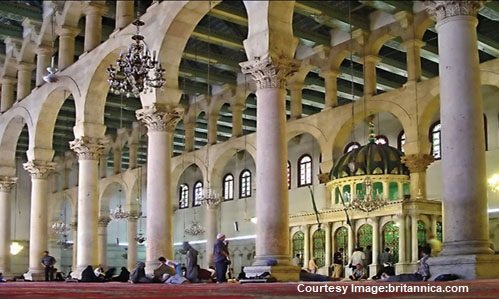
The walls and ceilings are adorned with intricate mosaics, depicting swirling floral patterns, geometric designs, and biblical scenes. Sunlight streams through stained glass windows, casting a kaleidoscope of colors across the marble floor. Towering columns, some with intricate carvings, line the vast prayer hall, creating a sense of awe and grandeur.
The artistry extends beyond the mosaics to the elaborate mihrab (prayer niche) and the minbar (pulpit), both adorned with precious materials and intricate craftsmanship.
The Umayyad Mosque’s interior is a testament to the rich artistic heritage of Islam and a true masterpiece of design.
Minaret of Umayyad Mosque
The mosque’s towering minaret punctuates the skyline, a marvel of architecture dating back to 727 CE. Its elegant form and historical resonance continue to inspire.
The Umayyad Mosque boasts three unique minarets, each with its own fascinating history and architectural style
Sayyidah Zaynab Mosque
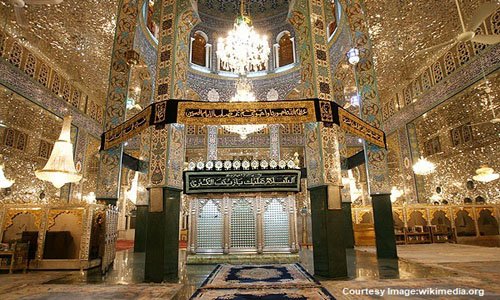
Journey to Damascus, Syria, and behold the splendor of the Sayyidah Zaynab Mosque. A glistening beacon of Islamic faith, this mosque is a significant pilgrimage site for Twelver Shia Muslims, believed to enshrine the tomb of Zaynab bint Ali, the granddaughter of Prophet Muhammad.
The mosque’s architecture is a captivating blend of styles, reflecting its rich history. The golden dome shimmers under the Syrian sun, while the intricately detailed tilework and towering minarets showcase the artistry of Islamic design. Inside, the mosque offers a serene atmosphere for prayer and contemplation.
The mosque’s architecture marries traditional and contemporary elements, with its iconic blue dome catching the eye.
- Address: Sayyidah Zaynab, Damascus.
- Capacity: Accommodates thousands of worshippers.
- It remains a mosque, embodying the essence of Shiite devotion.
- Opening hours vary with prayer times.
- No entry fee is required, as it’s open to all.
- Images of the mosque depict its majesty, attracting visitors worldwide.
- The mosque’s origins date back to the Umayyad era, solidifying its historical significance in the tapestry of Damascus.
The Sayyidah Ruqayya Mosque
Nestled amidst the vibrant city of Damascus, Syria, the Sayyidah Ruqayya Mosque, a place of profound peace and spiritual significance. Believed to enshrine the tomb of Ruqayya bint Ali, the granddaughter of Prophet Muhammad, this mosque serves as a revered pilgrimage site for Twelver Shia Muslims.

The Sayyidah Ruqayya Mosque boasts a captivating architectural style, reflecting a blend of influences. The golden dome, a characteristic feature of Islamic architecture, gleams majestically under the Syrian sun. Intricate tilework adorns the exterior walls, showcasing the artistry and craftsmanship inherent in Islamic design. Soaring minarets gracefully pierce the skyline, adding to the mosque’s grandeur.
Inside, the atmosphere is one of tranquility, inviting visitors to prayer and contemplation. The mosque’s design fosters a sense of serenity, providing a refuge for those seeking spiritual solace.
The Sayyidah Ruqayya Mosque, a symbol of reverence for Shiite Muslims, is nestled in the heart of Damascus. With origins dating back centuries, it holds profound spiritual significance. Its exquisite architecture and tranquil atmosphere invite contemplation.
- Location: Sayyidah Ruqayya, Damascus.
- Capacity: Welcoming countless worshippers. Continuing its legacy as a mosque,
- preserving its Shiite heritage. Visiting hours are aligned with prayer times.
- No admission fee is required. Captivating imagery showcases the mosque’s splendor.
- This mosque stands as a living testament to Syria’s diverse religious tapestry.
Al-Omari Mosque
Embark on a historical journey through the heart of Damascus, Syria, and discover the Al-Omari Mosque, a captivating landmark steeped in rich heritage. Believed to be built on the site of a former Christian church dedicated to John the Baptist, the mosque has undergone transformations throughout the centuries, reflecting the city’s evolving history.

The Al-Omari Mosque’s architectural style is a fascinating blend of Roman, Byzantine, and Islamic influences. The rectangular structure incorporates elements from the earlier church, while the towering minaret and prayer hall showcase Islamic architectural traditions.
Step inside the mosque and be greeted by a serene atmosphere. The interior space features towering columns, some believed to be remnants of the previous church, adding to the historical significance of the site.
A Center of Learning and Community:
Beyond its architectural wonders, the Al-Omari Mosque has served as a vital center for learning and community throughout its history. It housed a renowned library, attracting scholars and students from across the region. Today, the mosque continues to be a place of worship and social gathering for the local community.
The Al-Omari Mosque, located in Daraa, stands as a tribute to the enduring legacy of Islam. With a history steeped in tradition, it has borne witness to the ebb and flow of time. Its architectural grandeur reflects a harmonious blend of diverse styles.
- Address: Al-Omari Mosque, Daraa.
- Having served as a mosque since its inception, it remains dedicated to its sacred purpose.
- Visiting hours are harmonized with prayer timings.
- Entrance is graciously free of charge.
- Mesmerizing images capture the everlasting charm of the mosque.
- The mosque’s sturdy foundation symbolizes the deep roots of faith and community.
Sulaymaniyya Takiyya Mosque
Delve into the heart of Damascus, Syria, and discover the Sulaymaniyya Takiyya Mosque, a captivating architectural gem reflecting Ottoman grandeur. Built in the 16th century by Sultan Suleiman the Magnificent, this mosque stands as a testament to the artistic legacy of the Ottoman era.

The Sulaymaniyya Takiyya Mosque boasts a blend of architectural styles, showcasing influences from both Ottoman and Mamluk traditions. The imposing stone facade features intricate carvings and geometric patterns, reflecting the meticulous craftsmanship of the era. A graceful dome dominates the skyline, adding to the mosque’s majestic presence.
Step inside the mosque and be greeted by a spacious and serene atmosphere. The interior features towering columns, elegant arches, and beautiful calligraphy adorning the walls. Sunlight streams through stained glass windows, casting a warm glow on the intricate tilework adorning the floor.
More Than Just a Mosque:
The Sulaymaniyya Takiyya Mosque served not only as a place of worship but also as a caravanserai, a rest house for travelers. This unique dual purpose reflects the importance of hospitality and travel within Ottoman society.
The Sulaymaniyya Takiyya Mosque, situated in Aleppo, stands as a masterpiece of Ottoman architectural prowess. Constructed during the reign of Sultan Suleiman the Magnificent, it harmoniously blends elements of both mosque and takiyya (Sufi lodge). Its ornate façade and meticulous tilework exemplify the exquisite aesthetics of the Ottoman era.
- Address: Sulaymaniyya Takiyya, Aleppo.
- Capacity: Accommodates a considerable congregation.
- Remaining steadfast as a mosque, it epitomizes Aleppo’s rich spiritual heritage.
- Visiting hours may vary, aligned with prayer schedules.
- Entrance is open to all, without any admission fee.
- Enchanting photographs capture the mosque’s intricate beauty.
- Since its completion in 1557, the mosque has stood as a testament to faith and artistic brilliance, illuminating Aleppo’s skyline.
Nabi Habeel Mosque
Embark on a spiritual journey through Damascus, Syria, and discover the Nabi Habeel Mosque, a revered site believed to enshrine the tomb of Prophet Abel (Habil in Arabic). This mosque holds deep significance for Muslims and Christians alike, offering a glimpse into the rich tapestry of religious traditions in the region.

The Nabi Habeel Mosque showcases a modest architectural style, reflecting its focus on spiritual contemplation. The rectangular structure features a central courtyard and a prayer hall, offering a serene space for worship and reflection.
A Site of Shared Significance:
The mosque’s significance transcends religious boundaries. Believed to be the final resting place of Prophet Abel, the second son of Adam and Eve, it attracts pilgrims from both Islamic and Christian traditions who revere him as a figure of faith.
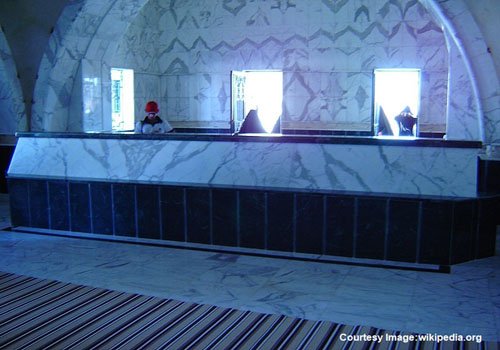
Sacred site in a Syrian mosque, believed to be the final resting place of Abel, son of Adam. Revered for its historical and spiritual significance.
The Nabi Habeel Mosque, nestled in Aleppo, bears religious importance for both Muslims and Christians.
Tradition links it to Abel’s resting place. Its modest yet evocative architecture mirrors its rich past.
- Location: Nabi Habeel, Aleppo.
- Maintaining its original role, it fosters unity among varied communities.
- Visiting hours coincide with prayer times.
- No admission fee encourages inclusivity.
- Photographs encapsulate the mosque’s tranquil aura.
- Rooted in mutual reverence, the mosque fosters interfaith harmony.
Sinan Pasha Mosque in Damascus
Journey through the historical streets of Damascus, Syria, and discover the Sinan Pasha Mosque, a captivating architectural gem nestled within the Old City. Built in the 16th century by the renowned Ottoman architect Mimar Sinan, this mosque stands as a testament to his exceptional design skills and the grandeur of Ottoman architecture.

The Sinan Pasha Mosque boasts a classical Ottoman architectural style, characterized by symmetry, elegance, and intricate details. The imposing stone facade features beautiful calligraphy and geometric patterns, showcasing the meticulous craftsmanship of the era. A graceful dome dominates the skyline, adding to the mosque’s majestic presence.The mosque dates from 1591, and originally the complex contained also a hammam, a school and market.
Step Inside a Haven of Serenity:
Enter the mosque and be greeted by a spacious and serene atmosphere. The interior features towering columns, elegant arches, and stunning stained glass windows that bathe the space in a warm glow. The intricate tilework adorning the floor and walls further enhances the mosque’s beauty.
More Than Just a Place of Worship:
The Sinan Pasha Mosque served not only as a religious center but also as a caravanserai, a rest house for travelers. This unique dual purpose reflects the importance of hospitality and travel within Ottoman society.
The Sinan Pasha Mosque, nestled in Damascus, exemplifies Ottoman refinement.
Crafted by celebrated architect Mimar Sinan, it boasts intricate features and balanced proportions.
- Location: Sinan Pasha, Damascus.
- Capacity: Accommodates gatherings for worship.
- Continuing its legacy as a mosque, honoring Ottoman heritage.
- Visiting hours coincide with prayers.
- Free admission promotes inclusivity.
- Photographs highlight its architectural splendor.
- Erected in 1590, the mosque remains a timeless symbol of Ottoman architectural prowess.
Aqsab Mosque
Tucked within Damascus’ bustling Old City is the Aqsab Mosque, a charming yet lesser-known gem. Built around the 15th century, its architecture is modest compared to grander mosques. Brick and stone likely formed the main structure, possibly incorporating elements from earlier buildings on the site.
Despite its simplicity, the Aqsab Mosque offers a tranquil space for prayer and reflection. The interior likely features a central courtyard and a prayer hall, fostering a sense of peace for the local community. The Aqsab Mosque reminds us that Damascus’ architectural treasures extend beyond famous landmarks, whispering stories of the past and showcasing the city’s enduring faith.
Constructed in the Umayyad era, its historical importance resonates through time.
- Location: Aqsab Mosque, Damascus.
- Capacity: Embraces worshippers and history aficionados.
- Preserving its role as a mosque, it echoes the Umayyad heritage.
- Visiting hours harmonize with prayer times.
- Admission is free.
- Photographs capture its enduring allure.
- Since its inception in the 8th century, the mosque reverberates with tales of a glorious past.
Nur al-Din Mosque
Embark on a historical journey through Damascus, Syria, and discover the Nur al-Din Madrasa, also known as the Nur al-Din Mosque. This captivating complex, built in the 12th century, stands as a testament to the architectural brilliance of the Zengid dynasty and the rich heritage of Islamic funerary architecture.

A Multifaceted Complex:
The Nur al-Din Madrasa was more than just a mosque; it functioned as a madrasa (Islamic school) and the mausoleum of Nur al-Din Zangi, a prominent ruler of the Zengid dynasty. This unique combination reflects the importance of education and religious scholarship within Islamic society.
Architectural Grandeur:
The Nur al-Din Madrasa showcases Seljuk architectural influences, characterized by intricate stonework and geometric patterns. The towering square-plan mausoleum dominates the complex, adorned with a mesmerizing muqarnas dome – a honeycomb-like structure characteristic of Islamic architecture.
Step Inside a Serene Sanctuary:
The interior of the mosque offers a haven of peace and tranquility. The prayer hall features elegant arches and columns, while the tomb chamber, accessible through a grille, provides a glimpse of Nur al-Din’s final resting place.
A Lasting Legacy:
The Nur al-Din Madrasa stands as a significant landmark in Damascus, not only for its architectural beauty but also for its historical significance. It serves as a reminder of the Zengid dynasty’s contributions to Islamic art and architecture and continues to inspire awe and reverence.
The Nur al-Din Mosque, an architectural jewel in Aleppo’s skyline, pays homage to medieval ruler Nur al-Din Zangi.
Dating back to the 12th century, its intricate design signifies a shift in architectural sophistication.
- Location: Nur al-Din Mosque, Aleppo.
- Capacity: Sacred haven for worshippers.
- Maintaining its status as a mosque, it carries forward a rich historical narrative.
- Visiting hours coincide with prayers.
- Entrance is free of charge.
- Photographs encapsulate its timeless allure.
- Since its inception, the mosque has stood witness to Aleppo’s dynamic narrative, blending faith and history seamlessly.
The Khalid Ibn Al-Walid Mosque in Damascus
Journey through the vibrant city of Damascus, Syria, and discover the Khalid Ibn Al-Walid Mosque, a place of worship steeped in history and military tradition. Dedicated to Khalid ibn al-Walid, a revered military leader in early Islam, the mosque serves as a testament to his legacy and the importance of faith within Islamic society.

A Blend of Architectural Influences:
The exact date of the Khalid Ibn Al-Walid Mosque’s construction remains uncertain, though estimates suggest it may have been built or significantly renovated during the Ottoman period. The mosque’s architectural style reflects a blend of influences, incorporating elements from earlier Mamluk and Ottoman architecture.
A Site of Spiritual Significance:
The Khalid Ibn Al-Walid Mosque is more than just a historical landmark; it serves as a vital center for worship and prayer for the local community. The mosque’s interior likely features a central courtyard and a prayer hall, offering a serene space for contemplation and spiritual connection.
The Legacy of Khalid Ibn Al-Walid:
Khalid ibn al-Walid, also known as “The Sword of Allah,” played a pivotal role in the early expansion of Islam. The mosque serves as a constant reminder of his courage, leadership, and unwavering devotion to his faith.
Embracing modernity while honoring his esteemed legacy, its contemporary design is a testament to progress.
- Location: Khalid Ibn Al-Walid Mosque, Homs.
- Capacity: Provides solace for worshippers.
- Maintaining its role as a mosque, it pays homage to his legacy.
- Visiting hours align with daily prayers.
- Entrance is free.
- Photographs showcase its unique architectural features.
- Established in the 20th century, this mosque commemorates the legacy of a revered military strategist.
Other Islamic Landmarks in Syria
- Unveiling the Citadel of Aleppo
- A Crusader Legacy: Unveiling the Krak des Chevaliers
- The Ancient City of Palmyra
- Unveiling the Roman Theatre of Bosra
- The Minaret of Isa (AS) in Damascus
- The Shrine of Yahya (AS) in Damascus
- The Tomb of Bilal ibn Rabah (AS) in Damascus
References: Own Research, Wikipedia.
Please note that this entry is provided for informational purposes only. It is imperative not to engage in praying to graves or seeking supplication through them, as this constitutes associating partners with Allah (ﷻ), which is strictly prohibited.
Related Post: Unveiling Jordan’s Gems
Also Read: Qasas Ul Anbiya, among the world’s best Islamic books in PDF
May You Like: Al Quran with Urdu Translation mp3
